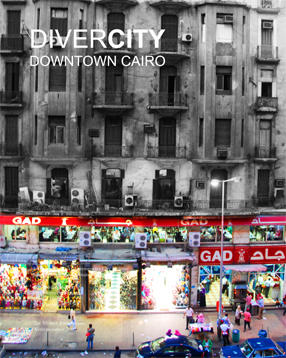Divercity
Downtown Cairo

Students: Julia Dyllong, Aiste Plentaite
Location: Cairo
Date: October, 2010
Type: Research project, student work
Since the publication of the novel Yacoubian Building by Alaa al Aswany, the image of Talat Harb Square is becoming increasingly used as the representative image for Cairo (this having shifted from the pyramids). Known as Wust El-Balad, which literally means the center of the city, the area of Downtown Cairo has come to represent the heart of the city since the onset of modernity and Cairo’s Belle Epoque. Key government buildings—such as the Mogamma Building which every Egyptian of age have had to enter for its bureaucratic administration, located on Tahrir Square, old banking centers, the Egyptian Museum, along with other buildings of regal splendor in Downtown.
Despite the exodus of the upper middle class to the suburbs following the departure of Cairo’s resident expat community in 1952 and the forboding “downgrade” by infiltrated commerce, the grandeur of the boulevards and buildings have not gone unnoticed today with the recent purchase of 15 key buildings by an important real-estate tycoon. The potential for a revitalization and gentrification of Downtown seems to be realizing itself slowly.
This topic will look at the preservation of cultural heritage from Cairo’s Belle Epoque and Egypt’s encounter with modernity—what is known as downtown Cairo began as the modernization project under Khedive Ismail, the grandson of Muhammad Ali, who is considered the “father of modern Egypt” and the influence of Hausmannian planning and landscaping are visible in the thoroughfares and 13 maidans (squares) realized. With focus on the two points of Talat Harb Square and Tahrir Square as the drills within this drill the ideologically shaped past of Cairo city center will be examined. The larger conceptual framework of the forces of neoliberalism and informality simultaneously operating on spatial production will in this topic intersect with the issues of cultural identity, modern heritage, urban rejuvenation and future development.
Download the Book PDF

